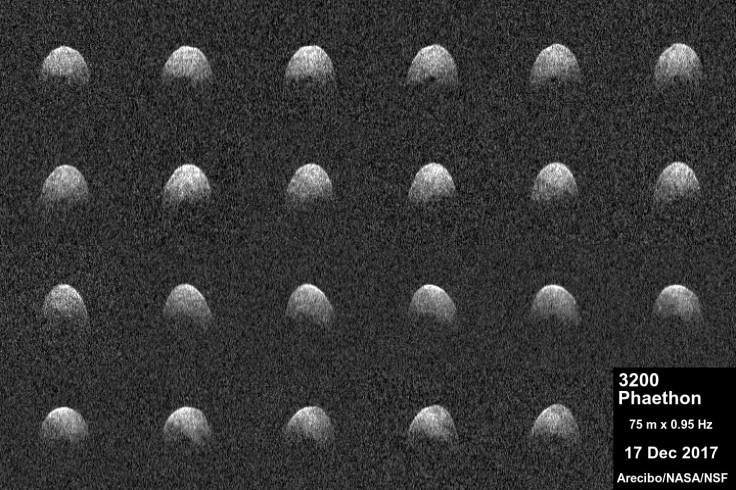3200 Phaethon Pictures Show Dark Heart Of ‘Potentially Hazardous’ Giant Asteroid

An asteroid NASA has called “potentially hazardous” was caught whizzing by Earth shortly before Christmas, showing astronomers the dark void at its heart.
The Arecibo Observatory in Puerto Rico used its radio telescope to keep an eye on asteroid 3200 Phaethon during its close approach to the planet, creating radar images that revealed new features of the space rock. According to NASA, the asteroid is roughly shaped like a ball and “has a large concavity, or depression, at least several hundred meters in extent near its equator, and a conspicuous dark, circular feature near one of the poles.”
Arecibo is in an area that was battered by Hurricane Maria earlier this year, and returned to its asteroid-watching activities this month.
NASA called the new crop of photos the “highest-resolution images to date” of Phaethon.
“These new observations of Phaethon show it may be similar in shape to asteroid Bennu, the target of NASA’s OSIRIS-REx spacecraft, but more than 1,000 Bennus could fit inside of Phaethon,” Patrick Taylor a scientist at Arecibo Observatory, said in the NASA statement.
OSIRIS-REx is currently on its way to Bennu, where it will map the surface of the asteroid and collect samples using its robotic arm. Bennu is almost as old as the solar system, so learning more about it could give scientists more clues about how our space neighborhood formed.

“Scientists think asteroids like Bennu may have collided with Earth a long time ago, seeding our planet with the organic compounds that made life possible,” NASA said at the time. “That means that there’s a good chance Bennu contains answers to fundamental questions about the origins of life and how our solar system came to be. We sent OSIRIS-REx on a journey to investigate.”
The spacecraft will reach Bennu in 2018 and is expected to return home with samples in 2023.
There’s no mission planned to Phaethon, but astronomers have known about it since the 1980s and it is the second-largest asteroid near Earth that experts have labeled as being “potentially hazardous” because of its size and proximity to the planet. The new observations, taken as it was about 6.4 million miles away, indicate it is about 3.6 miles across.
Taylor said that dark depression at Phaethon’s center “could be a crater or some other topographic depression that did not reflect the radar beam back to Earth.”
Our #TeamRadar returns with great images of near-Earth asteroid 3200 Phaethon! #NASAfunded #AreciboScience https://t.co/Jh4Pu97601
SaveSave
© Copyright IBTimes 2024. All rights reserved.





















